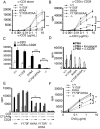Cutting edge: A double-mutant knockin of the CD28 YMNM and PYAP motifs reveals a critical role for the YMNM motif in regulation of T cell proliferation and Bcl-xL expression
- PMID: 24639356
- PMCID: PMC3994466
- DOI: 10.4049/jimmunol.1301240
Cutting edge: A double-mutant knockin of the CD28 YMNM and PYAP motifs reveals a critical role for the YMNM motif in regulation of T cell proliferation and Bcl-xL expression
Abstract
CD28 is a critical regulator of T cell function, augmenting proliferation, cytokine secretion, and cell survival. Our previous work using knockin mice expressing point mutations in CD28 demonstrated that the distal proline motif was primarily responsible for much of CD28 function, whereas in marked contrast to prior studies, mutation of the PI3K-binding motif had little discernible effect. In this study, we examined the phenotype of mice in which both motifs are simultaneously mutated. We found that mutation of the PYAP motif unmasks a critical role for the proximal tyrosine motif in regulating T cell proliferation and expression of Bcl-xL but not cytokine secretion. In addition, we demonstrated that, although function is more severely impaired in the double mutant than in either single mutant, there remained residual CD28-dependent responses, definitively establishing that additional motifs can partially mediate CD28 function.
Figures




References
-
- Michel F, Attal-Bonnefoy G, Mangino G, Mise-Omata S, Acuto O. CD28 as a molecular amplifier extending TCR ligation and signaling capabilities. Immunity. 2001;15:935–945. - PubMed
-
- Pagès F, Ragueneau M, Rottapel R, Truneh A, Nunes J, Imbert J, Olive D. Binding of phosphatidylinositol-3-OH kinase to CD28 is required for T- cell signalling. Nature. 1994;369:327–329. - PubMed
-
- Schneider H, Cai YC, Prasad KV, Shoelson SE, Rudd CE. T cell antigen CD28 binds to the GRB-2/SOS complex, regulators of p21ras. Eur J Immunol. 1995;25:1044–1050. - PubMed
-
- Kim HH, Tharayil M, Rudd CE. Growth factor receptor-bound protein 2 SH2/SH3 domain binding to CD28 and its role in co-signaling. J Biol Chem. 1998;273:296–301. - PubMed
Publication types
MeSH terms
Substances
Grants and funding
LinkOut - more resources
Full Text Sources
Other Literature Sources
Molecular Biology Databases
Research Materials

